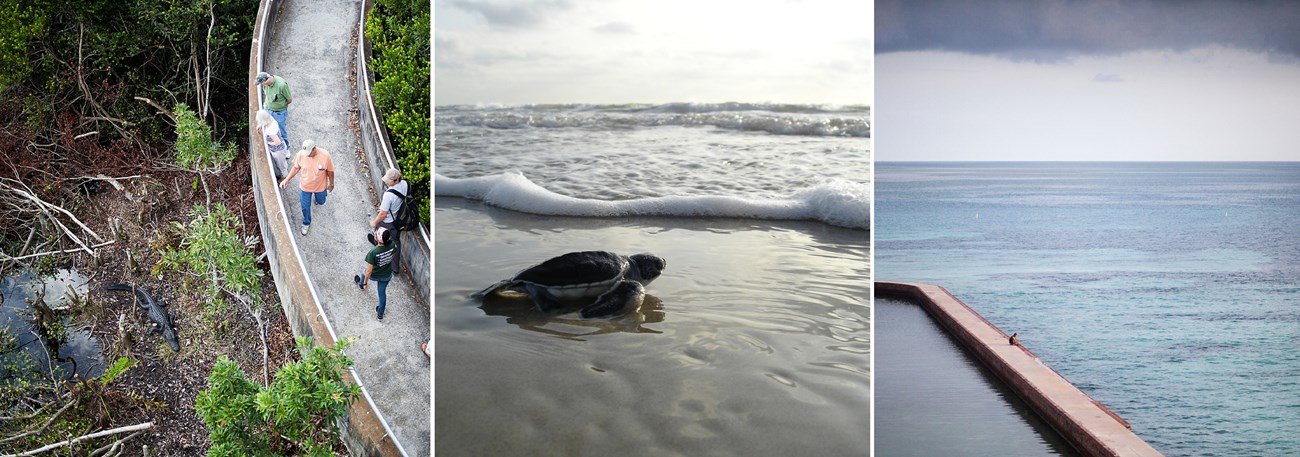|
Visit one of the most vibrant coral and seagrass communities in Florida; see American alligators bask in the sun near cypress trees or watch sea turtles hatch at one of the eight National Park Service’s Gulf Coast parks. These parks offer great fishing and water paddling opportunities. Be sure to bring your snorkeling gear to see the dynamic ocean habitats located at these parks.
Gulf of Mexico Ocean and Coastal National Parks
Texas
Padre Island National Seashore
- 417 Shoreline Miles
- 72,478 Marine Water Acres
- Padre Island National Seashore separates the Gulf of Mexico from the Laguna Madre, one of a few hypersaline lagoons in the world. The park protects 70 miles of coastline, dunes, prairies, and wind tidal flats teeming with life. It is a safe nesting ground for the Kemp’s ridley sea turtle and a haven for 380 bird species. It also has a rich history, including the Spanish shipwrecks of 1554.
Big Thicket National Preserve
- 4.7 Shoreline Miles
- Life of all types abounds in the Big Thicket. This national preserve protects the incredible diversity of life found where multiple habitats converge in southeast Texas. Hiking trails and waterways meander through nine different ecosystems, from longleaf pine forests to cypress-lined bayous. It is a place of discovery, a place to wander and explore, a place to marvel at the richness of nature.
Louisiana
Jean Lafitte National Historical Park and Preserve
- 87 Shoreline Miles
- 1,546 Marine Water Acres
- In Jean Lafitte's day, silver and gold filled a pirate's treasure chest, but today's treasures are people, places, and memories. Discover New Orleans’ rich cultural mix. Learn Cajun traditions from people who live them. Watch an alligator bask on a bayou’s bank. Walk in the footsteps of the men who fought at 1815’s Battle of New Orleans.
Florida
Gulf Islands National Seashore
- 227.6 Shoreline Miles
- 111,882 Marine Water Acres
- What is it that entices people to the sea? Poet John Masefield wrote, “I must go down to the seas again, for the call of the running tide is a wild call and a clear call that may not be denied.” Millions of visitors are drawn to the islands in the northern Gulf of Mexico for the white sandy beaches, the aquamarine waters, a boat ride, a camping spot, a tour of an old fort, or a place to fish.
De Soto National Memorial
- 0.7 Shoreline Miles
- In May 1539, Conquistador Hernando de Soto’s army of soldiers, hired mercenaries, craftsmen and clergy made landfall in Tampa Bay. They were met with fierce resistance of indigenous people protecting their homelands. De Soto’s quest for glory and gold would be a four year, four thousand mile odyssey of intrigue, warfare, disease, and discovery that would form the history of the United States
Big Cypress National Preserve
- 24 Shoreline Miles
- 373 Marine Water Acres
- The freshwaters of the Big Cypress Swamp, essential to the health of the neighboring Everglades, support the rich marine estuaries along Florida's southwest coast. Protecting over 729,000 acres of this vast swamp, Big Cypress National Preserve contains a mixture of tropical and temperate plant communities that are home to a diversity of wildlife, including the elusive Florida panther.
Everglades National Park
- 2,452 Shoreline Miles
- 547,240 Marine Water Acres
- Everglades National Park protects an unparalleled landscape that provides important habitat for numerous rare and endangered species like the manatee, American crocodile, and the elusive Florida panther. An international treasure as well - a World Heritage Site, International Biosphere Reserve, a Wetland of International Importance, and a specially protected areas under the Cartagena Treaty.
Dry Tortugas National Park
- 5.4 Shoreline Miles
- 65,476 Marine Water Acres
- Almost 70 miles (113 km) west of Key West lies the remote Dry Tortugas National Park. The 100-square mile park is mostly open water with seven small islands. Accessible only by boat or seaplane, the park is known the world over as the home of magnificent Fort Jefferson, picturesque blue waters, superlative coral reefs and marine life, and the vast assortment of bird life that frequent the area.
|

